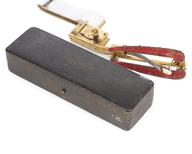


Kymograph, brass and steel, on mahogany baseboard, French, c.1870
The kymograph is a classic tool of laboratory research. It was invented by German physiologist Carl Ludwig (1816-1895) in 1847. One of its earliest uses was measuring blood pressure during physiological experiments. A cannula connected to a U-shaped tube filled with mercury was inserted into the artery of an animal. On top of the mercury was a float attached to a pen. As the blood pulsated, the pen recorded the movement on smoked paper wrapped around the metal drum.
The kymograph transformed experimental physiology. The graphs produced let physiologists see blood pressure on paper, giving them a permanent record of the experiment. This example was used in intricate experiments on the properties of muscles and nerves.
Details
- Category:
- Clinical Diagnosis
- Collection:
- Sir Henry Wellcome's Museum Collection
- Object Number:
- A606315
- Measurements:
-
overall: 67 mm x 160 mm x 62 mm,
overall (main body ): 150 mm x 222 mm x 120 mm, 2.8kg
- type:
- kymograph




